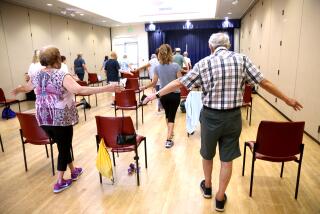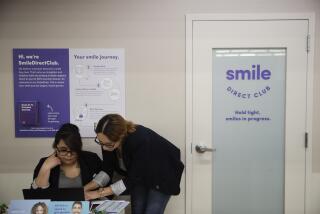BODY WATCH : Older and Wired : For those over 50, tin grins are in. Braces can help give adults a future with healthy teeth instead of false ones.
- Share via
After a year of wearing braces, Bill Bates was ready to get those puppies off.
He had spent all of 1991 sporting the latest hip-colored elastic ligatures on his braces--red, white and blue in support of U.S. troops in Operation Desert Storm.
Now it was time to take off the tinsel--braces that had taken him five years to get after finally convincing Scott Bates that he was dead serious about having his teeth straightened.
Why the tough sell? Bill, at the time, was a 75-year-old retiree.
“I didn’t realize how much it meant to him,” says son Scott, a San Antonio orthodontist. “We know that healthy teeth can be moved and my dad was a perfect candidate, so finally I said, ‘Let’s go for it.’ ”
Anne Pepys had worn braces when she was a teen-ager and for about 10 years, everything was fine. Gradually, though, the Rancho Palos Verdes woman’s mouth underwent changes--gum disease--which eventually led to the loss of several teeth--and overbite.
“It was not getting any better. It was getting worse,” she says. So at age “over 50,” Anne Pepys decided to get braces in March, 1993. They should be off by the end of the year.
“(Older) people stop me now and they say, ‘Honey, is it worth it?’ and I tell them, ‘Yes! Do it.’ ”
*
Twenty years ago, people on the upside of 50 might have considered orthodontics kid stuff. Today, “tin is in” and there are few reasons older adults shouldn’t wear braces.
The number of adults with braces has exploded, doubling the once rare numbers from a decade ago. According to the American Assn. of Orthodontists, one in four patients today is an adult. (Although there are no hard statistics on the numbers of older adults in braces, anecdotal evidence from orthodontists shows an increase.)
The motivation to wear braces later in life goes well beyond cosmetics. “People are getting braces for health reasons,” says Dr. Ralph Allman, a Torrance orthodontist. (Half his practice is adults.) “They are realizing that if they let these problems go, it can lead to gum disease and tooth loss.”
“Not so long ago, it was considered a part of one’s lifestyle to lose all your teeth and wear false teeth,” adds Dr. Donald Poulton, head of orthodontics at University of Pacific School of Dentistry, San Francisco. “In highly developed countries that’s just not true anymore.”
He also notes that teeth are on the move our entire lives--not just when we’re teen-agers. “It’s one reason why many adults who wore braces as kids are back in them as adults.”
For many older patients who seek restorative treatment, braces lay the groundwork for filling crowns and building bridges.
“Bridges usually last longer after orthodontic work,” Allman says.
One of his patients--Ron Delhomme, 53, of Harbor City--is undergoing orthodontic treatment to make way for a bridge.
“I was never a fan of the dentist,” Delhomme says. “It seemed back in the ‘40s the way they corrected things was just to pull the tooth. At a young age, I had four on the top and the bottom pulled, and had a partial. As a result my back teeth moved sideways as a chewing surface.”
Delhomme not only likes the way his teeth look now, but says he seems to chew food better.
*
Tom Rogers elected to wear braces at age 45. The idea of keeping his own choppers well into his retirement years was all the impetus he needed.
“My two front teeth were beginning to cross. The dentist told me it could get to the point of affecting my bone structure under the upper gums. My tongue had also starting hitting my upper tooth when I talked and I worried it was affecting my speech,” says Rogers, of Scio, Ore.
It was a tough choice, but Rogers wore braces for three years and grew to love it.
“I’m assured now that when I’m 60 or 70, I’ll still have all my own teeth. There was never a time I felt I had made the wrong decision.”
Seniors with crowding teeth are also likely candidates for gum disease--and orthodontics.
Allman finds many patients don’t realize there’s a problem until a routine examination when a pocket is found in the gum, signifying bone loss.
“I’ve had a lot of patients who were earmarked for gum surgery and we had them cleaned by a periodontal hygienist, then go through orthodontic work and subsequently end up with very little periodontal work,” Allman says.
*
Radical changes in the technology behind orthodontics make wearing braces a cake-walk for older adults today. Years ago, braces meant metal bands holding a bracket fitted onto each tooth, which in turn held a metal wire. Today, metal, clear or ceramic brackets cemented to each tooth make braces appealing and easier to care for.
Adjustments no longer feel like a trip to the torture chamber. Flexible and resilient space-age wires produce lighter forces on the teeth for longer periods, resulting in less painful treatment.
Insurance companies are also recognizing orthodontics as a valid medical procedure and are increasingly picking up the tab, which can range from $1,500 to $5,000.
*
When Carole Orth of Lansing, Mich., noticed one of her front teeth starting to twist, she thought it might lead to bigger problems.
“People who have oral problems have health problems,” she says. “I looked at it this way: Your mouth is the first part of your digestive system and it became a total health issue for me.”
At 54, Orth “braced her face” for 17 months. “A lot of people admired me for having the guts to wear the braces, but I wanted to enjoy my teeth at the same time I was enjoying Social Security,” she says.
Allman says the common thread that binds his adult patients is an age-defying positive outlook. Allman also finds putting adults and youths in treatment chairs side by side a win-win situation.
“I’ve heard (adults) telling teens, ‘I wasn’t a good brusher as a kid and now I’m here’ or ‘I didn’t wear my retainer and now I’m back in braces because of it.’ The kids will listen,” Allman says.
Put on a Happy Face
The American Assn. of Orthodontists can put a smile on your face by using computer-imaging.
To receive a complimentary computer-generated photo of how you might look after orthodontic treatment, send a color close-up frontal photograph with a wide toothy smile, along with your name, address and phone number to Smiles, American Assn. of Orthodontists, 401 North Lindbergh Blvd., St. Louis, MO 63141-7816. Telephone: (800) 222-9969.
More to Read
Sign up for Essential California
The most important California stories and recommendations in your inbox every morning.
You may occasionally receive promotional content from the Los Angeles Times.













